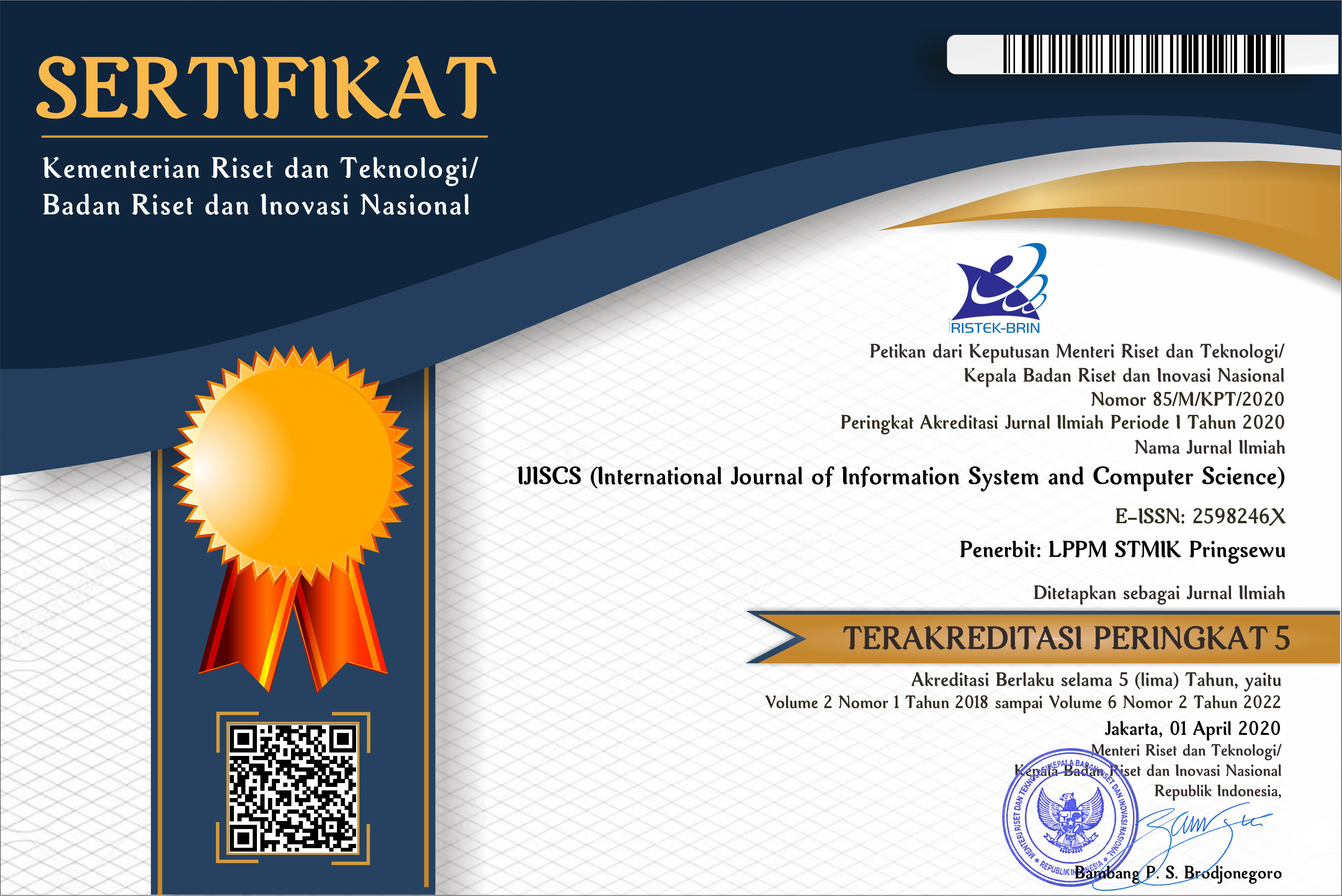DESIGNING AN ANDROID-BASED DIGITAL MUSEUM APPLICATION AS A VIRTUAL VISIT TO THE MUSEUM
(1) Departement of Informatics Engineering, Politeknik Caltex Riau, Riau
(2) Departement History Education, Riau University, Riau
 Corresponding Author
Corresponding Author
Abstract
Keywords
References
Wikipedia, “Museum Sang Nila Utama.” https://id.wikipedia.org/wiki/Museum_Sang_Nila_Utama (accessed Jun. 06, 2022).
C. H. Punzalan and L. M. Escalante, “Museum Trip to Enrich Environmental Awareness and Education,” International Electronic Journal of Environmental Education, vol. 11, no. 1, pp. 13–23, 2021, doi: 10.18497/iejeegreen.759224.
N. Temiz, “An Instructional Planning and Implementation of a Museum Tour Addressing Multiple Intelligences for First Graders,” Participatory Educational Research, vol. 8, no. 3, pp. 24–43, 2021, doi: 10.17275/per.21.52.8.3.
Syarifuddin, Z. Syahrial, and A. Suparman, “Virtual Museum : A Learning Material of Indonesia National History,” International Journal of Multicultural and Multireligious Understanding, vol. 4, no. 6, pp. 51–60, 2017.
K. Perera, “The Role of Museums in Cultural and Heritage Tourism for Sustainable Economy in Developing Countries,” Regional Centre for Strategic, vol. 8, no. August 2013, pp. 1–6, 2015.
S. Azzahra and F. E. Febriansyah, “Aplikasi Pengenalan Koleksi Museum Lampung Berbasis Android,” Jurnal Komputasi, vol. 7, no. 1, pp. 40–47, 2019, doi: 10.23960/komputasi.v7i1.1719.
T. Teslyuk, V. Teslyuk, H. Lypak, N. Kunanets, and N. Veretennikova, “A Mobile Museum Guide Application,” in CEUR Workshop Proceedings, 2020, vol. 2631, no. July, pp. 314–326.
M. F. Döker and C. Kirlangiçoğlu, “Promotion of Cultural Heritages Through A Virtual Museum Platform: Case Study Hagia Sophia,” Sakarya University Journal of Science, vol. 22, no. 5, pp. 1–1, 2018, doi: 10.16984/saufenbilder.392091.
P. Haryani and J. Triyono, “The Designing of Interactive Learning Media at Yogyakarta’s Sandi Museum based on Augmented Reality,” International Journal on Informatics Visualization, vol. 4, no. 1, pp. 52–57, 2020, doi: 10.30630/joiv.4.1.157.
N. Ghouaiel, S. Garbaya, J. M. Cieutat, and J. P. Jessel, “Mobile Augmented Reality in Museums : Towards Enhancing Visitor’s Learning Experience,” International Journal of Virtual Reality, vol. 17, no. 1, pp. 21–31, 2017, doi: 10.20870/ijvr.2017.17.1.2885.
L. N. Amali, W. S. Husain, M. R. A. Kaluku, and S. Suhada, “Implementation of Augmented Reality as an Information Media for the Collection of the Popa-Eyato Museum,” Jambura Journal of Informatics, vol. 4, no. 1, pp. 01–12, 2022, doi: 10.37905/jji.v4i1.13954.
D. Marques and R. Costello, “Concerns and Challenges Developing Mobile Augmented Reality Experiences for Museum Exhibitions,” Curator, vol. 61, no. 4, pp. 541–558, 2018, doi: 10.1111/cura.12279.
F. Dwi, B. Sakti, and R. Umar, “the Visualisation of Muhammadiyah Museum,” Sinergi, vol. 25, no. 2, pp. 119–126, 2021.
H. Lee, T. H. Jung, M. C. tom Dieck, and N. Chung, “Experiencing Immersive Virtual Reality in Museums,” Information and Management, vol. 57, no. 5, p. 103229, 2020, doi: 10.1016/j.im.2019.103229.
M. Suryani, R. S. Rusidiawan, and R. Rosadi, “Development of Historical Learning Media Based on Virtual Reality of The National Awakening Museum,” vol. 7, no. 2, pp. 125–131, 2022.
Statcount, “Mobile Operating System Market Share Indonesia.” https://gs.statcounter.com/os-market-share/mobile/indonesia (accessed Jun. 09, 2022).
D. Naga Malleswari, M. P. Kumar, D. Sathvika, and B. A. Kumar, “A Study on SDLC for Water Fall and Agile,” International Journal of Engineering and Technology(UAE), vol. 7, no. 2, pp. 10–13, 2018, doi: 10.14419/ijet.v7i2.32.13516.
E. Bayu Kristanto, S. Andrayana, U. Nasional, J. Sawo Manila, K. Jakarta Selatan, and D. Khusus, “Application of Waterfall SDLC Method in Designing Student’s Web Blog Information System at the National University,” Jurnal Mantik, vol. 4, no. 1, pp. 472–482, 2020, [Online]. Available: https://iocscience.org/ejournal/index.php/mantik.
S. Herawati, Y. D. P. Negara, H. F. Febriansyah, and D. A. Fatah, “Application of the Waterfall Method on a Web-Based Job Training Management Information System at Trunojoyo University Madura,” E3S Web of Conferences, vol. 328, p. 04026, 2021, doi: 10.1051/e3sconf/202132804026.
M. Rohandi, N. Husain, and I. Wirahmi Bay, “Usability Testing of Intensive Course Mobile Application Using the Usability Scale System,” ILKOM Jurnal Ilmiah, vol. 13, no. 3, pp. 252–258, 2021, [Online]. Available: http://dx.doi.org/10.33096/ilkom.v13i3.821.252-258.
Mochammad Aldi Kushendriawan, Harry Budi Santoso, Panca O. Hadi Putra, and Martin Schrepp, “Evaluating User Experience of a Mobile Health Application ‘Halodoc’ using User Experience Questionnaire and Usability Testing,” Jurnal Sistem Informasi, vol. 17, no. 1, pp. 58–71, 2021, doi: 10.21609/jsi.v17i1.1063.
Article Metrics
Abstract View : 181 times
: 181 times Download : 57 times
Download : 57 times
DOI: 10.56327/ijiscs.v6i3.1260
Refbacks
- There are currently no refbacks.






